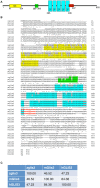GLIS3 and Thyroid: A Pleiotropic Candidate Gene for Congenital Hypothyroidism
- PMID: 30555422
- PMCID: PMC6281699
- DOI: 10.3389/fendo.2018.00730
GLIS3 and Thyroid: A Pleiotropic Candidate Gene for Congenital Hypothyroidism
Abstract
Variations in the transcription factor Gli-similar 3 (GLIS3) gene have been associated to variable congenital endocrine defects, including both morphogenetic and functional thyroid alterations. Evidence from Glis3 knockout mice indicates a relevant role for GLIS3 in thyroid hormone biosynthesis and postnatal thyroid gland growth, with a mechanism of action downstream of the TSH/TSHR interaction. However, the pathophysiological role of this transcription factor during the embryonic thyroid development remains unexplored. In this manuscript, we will provide an overview of the current knowledge on GLIS3 function during development. As a perspective, we will present preliminary evidence in the zebrafish model in support of a potential role for this pleiotropic transcription factor in the early stages of thyroid gland development.
Keywords: GLIS3; congenital hypothyroidism; sonic hedgehog; thyroid; zebrafish.
Figures


Similar articles
-
Transcription factor GLIS3: Critical roles in thyroid hormone biosynthesis, hypothyroidism, pancreatic beta cells and diabetes.Pharmacol Ther. 2020 Nov;215:107632. doi: 10.1016/j.pharmthera.2020.107632. Epub 2020 Jul 18. Pharmacol Ther. 2020. PMID: 32693112 Free PMC article. Review.
-
Glis3 as a Critical Regulator of Thyroid Primordium Specification.Thyroid. 2020 Feb;30(2):277-289. doi: 10.1089/thy.2019.0196. Epub 2020 Jan 27. Thyroid. 2020. PMID: 31797737
-
GLIS3 is indispensable for TSH/TSHR-dependent thyroid hormone biosynthesis and follicular cell proliferation.J Clin Invest. 2017 Dec 1;127(12):4326-4337. doi: 10.1172/JCI94417. Epub 2017 Oct 30. J Clin Invest. 2017. PMID: 29083325 Free PMC article.
-
GLIS3 expression in the thyroid gland in relation to TSH signaling and regulation of gene expression.Cell Mol Life Sci. 2024 Jan 28;81(1):65. doi: 10.1007/s00018-024-05113-6. Cell Mol Life Sci. 2024. PMID: 38281222 Free PMC article.
-
The role of GLIS3 in thyroid disease as part of a multisystem disorder.Best Pract Res Clin Endocrinol Metab. 2017 Mar;31(2):175-182. doi: 10.1016/j.beem.2017.04.007. Epub 2017 Apr 21. Best Pract Res Clin Endocrinol Metab. 2017. PMID: 28648506 Review.
Cited by
-
Updates on Genes and Genetic Mechanisms Implicated in Primary Angle-Closure Glaucoma.Appl Clin Genet. 2021 Mar 9;14:89-112. doi: 10.2147/TACG.S274884. eCollection 2021. Appl Clin Genet. 2021. PMID: 33727852 Free PMC article. Review.
-
[Copy number variation and parental consanguinity elevated in newborns of high altitude with major congenital anomalies in Perú].Rev Fac Cien Med Univ Nac Cordoba. 2022 Jun 6;79(2):132-140. doi: 10.31053/1853.0605.v79.n2.34538. Rev Fac Cien Med Univ Nac Cordoba. 2022. PMID: 35700460 Free PMC article. Spanish.
-
Transcription factor GLIS3: Critical roles in thyroid hormone biosynthesis, hypothyroidism, pancreatic beta cells and diabetes.Pharmacol Ther. 2020 Nov;215:107632. doi: 10.1016/j.pharmthera.2020.107632. Epub 2020 Jul 18. Pharmacol Ther. 2020. PMID: 32693112 Free PMC article. Review.
-
Borealin/CDCA8 deficiency alters thyroid development and results in papillary tumor-like structures.Front Endocrinol (Lausanne). 2023 Oct 27;14:1286747. doi: 10.3389/fendo.2023.1286747. eCollection 2023. Front Endocrinol (Lausanne). 2023. PMID: 37964961 Free PMC article.
-
From Endoderm to Progenitors: An Update on the Early Steps of Thyroid Morphogenesis in the Zebrafish.Front Endocrinol (Lausanne). 2021 Jun 4;12:664557. doi: 10.3389/fendo.2021.664557. eCollection 2021. Front Endocrinol (Lausanne). 2021. PMID: 34149617 Free PMC article. Review.
References
LinkOut - more resources
Full Text Sources
Molecular Biology Databases
Research Materials

